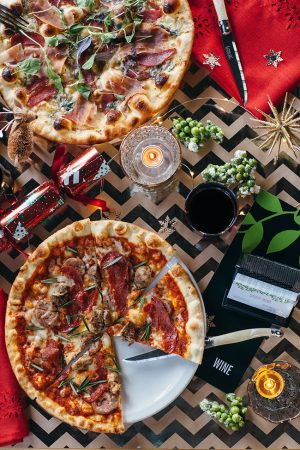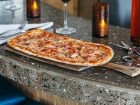
Feasting with your eyes
By Andrew Hind
Features Business and Operations Marketing andrew hind food photography frank mazzuca kelly neil pizza marketing pizza photographyLearn how good food photography can help sell your pizza
 This photo layout for Larry Uteck’s Bedford West location of Morris East in Bedford, N.S., draws the eye – and appetite – with appealing details. Photo by Kelly Neil, kellyneil.com
This photo layout for Larry Uteck’s Bedford West location of Morris East in Bedford, N.S., draws the eye – and appetite – with appealing details. Photo by Kelly Neil, kellyneil.comWhen it comes to food, many people think the most important sense is taste. After all, a meal that we savour and indulge in is the goal of every dining experience.
But arguably more important is our vision. As the old refrain goes, people eat with their eyes: in supermarkets we make purchases based on the packaging or display signage, in restaurants we order based on what looks appealing on the menu or what neighbouring diners are eating, and the first impression of our meal as it arrives – either from our oven or from a server’s hands – sets the stage for whether the experience will be a memorable one.
You know what they say about a picture being worth a thousand words? Well, it’s true, and it particularly applies when it comes to success in the restaurant industry.
“With the rise of social media over the last number of years, I think it’s smart to think of food photography as a modern form of a commercial. Where people used to sit after work watching the news, with commercials in between, these days people see ‘commercials’ while scrolling through their various feeds,” explains Kelly Neil, a full-time food photographer, food stylist and food writer from Nova Scotia. “A friend of mine recently referred to seeing a great food photo on social media as ‘planting the seed,’ basically, planting a visual thought in the viewer’s subconscious for the next time they decide to go out.”
Neil saw the importance of great food photography firsthand during her time as general manager of Ristorante a Mano in Bishop’s Landing. She knows it drives sales and enhances the customer experience.
Photography is vital to creating impact in marketing food, says Frank Mazzuca. Mazzuca has spent a lifetime doing just that as a creative director and graphic designer collaborating with brands like Costco and CarryHot Bags. “People experience first through sight, and then react according to how they feel about what they see,” he says. “In a food magazine, photos of delicious-looking dishes compel you to try the recipe, right? The same applies to marketing and selling food of any kind, including pizza. There’s so much competition out there. Brands need to set themselves apart and the best way to do that is with a perfectly executed and well-shot photograph.”
Great photos are absolutely essential for a restaurant’s menu. The menu represents the customer’s first impression of your food. Most people like to see a photo of their food before they order so they know exactly what they are getting. Unlike with the written word, there’s no ambiguity in a photo: everyone can understand a photo.
This is increasingly important in our multicultural world where English might be a second language for some customers, one they are not entirely fluent in. A photograph crosses all language barriers.
Furthermore, by choosing which particular high-margin dishes that you want to feature most prominently on your menu you can subtly guide your customers’ choices and increase profits.
A lot of creative thought, careful planning and artful execution go into producing the perfect food shot. Food photography requires the understanding of light, camera angles, lens selection and creative food styling in order to make a beautiful shot. It’s a blend of craft and art.
“It takes a lot of skill and experience to produce professional quality food photos,” explains Mazzuca, who actually produced a book entirely composed of stunning pizza imagery. “The pizzeria business is now more competitive than ever, with business owners fighting for their share of the market. Anything one can do to set their pizzeria and their food apart must be embraced, so you should find a professional to shoot your photos.”
Neil agrees. “Don’t let budget stop you from having great photos to promote your business. If you have any budget, you can always reach out to a food photographer and ask about options, or even, if you want to do it yourself, about in-person lessons or workshops.”
How do you find a food photographer to work with? Neil has some suggestions. “I think paying attention to what people are doing on social media is a great place to start. Look for restaurants or businesses whose images capture a tone you like, then reach out and ask who did their photography. Another way to search is by using geographic hashtags: if you’re based in Dartmouth, for example, look for the #dartmouth hashtag, find images you like, and then reach out in a message. Google works too, but pretty much everyone who creates images is on Instagram.”
If, for reasons of budget constraints, you elect to take photos yourself, Mazzuca stresses that light is the most important consideration. Too bright and the light may reflect off the pizza in an unappetizing way. Too dark and the pie will appear cast in shadows and unappealing.
“There are two kinds of lighting: controlled and natural. Both have their advantages but I prefer natural sources because light casts itself across the pizza in an elegant way. Natural light looks stunning on Instagram. Flash photography is an absolute no-no,” he stresses. “A favourite trick when it comes to food photography is to bounce light back at the subject of the photo. You can use a light screen, but even a white envelope, sheet of paper, or pie plate will work. The bounced-back light ensures the pizza is cast evenly in light, and the pizza glistens beautifully.”
Be sure to research “food photography tips” online – there’s a lot of information available to help you hone your skills.
Stunning, stomach-growl-inducing food photography is vital to the success of any food industry business. One of the best ways to set yourself apart is to ensure your pies are as visually appealing as they are savourful.
Andrew Hind is a freelance writer from Bradford, Ont., specializing in food, history and travel. He is the author of 25 books and the proud father of one.
Print this page



